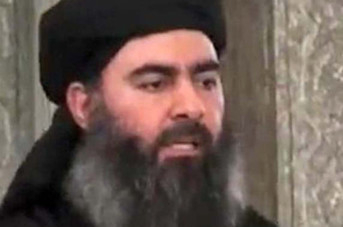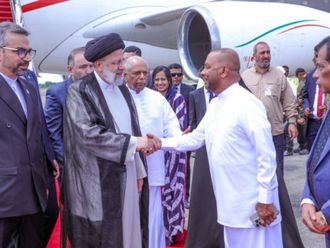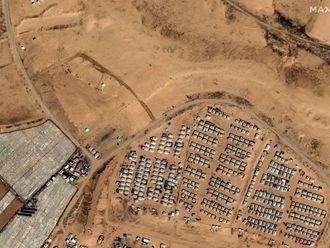
Baghdad: His self-declared caliphate was in ruins when Abu Bakr Al Baghdadi summoned some of his top aides to a meeting in eastern Syria last year. Daesh’s capital in Iraq had already fallen, and its Syrian headquarters was under siege.
Yet the terrorist leader had something else on his mind: schoolchildren.
The gathering near the city of Deir Al Zor was called by Al Baghdadi personally to discuss rewriting the terrorist group’s educational curriculum, according to a Daesh terrorist who was arrested in a joint operation by Turkish and Iraqi officials earlier this year. Despite the group’s dire circumstances, Al Baghdadi wanted to examine a subject that had less to do with immediate survival than with preserving the organisation’s ideological core.
“Several top leaders were present, as well as the curricula committee, which I headed,” the captured terrorist, known as Abu Zaid Al Iraqi, said in a videotaped statement aired on Iraqi television.
The meeting, said to have occurred in mid-2017, was the third convening of a committee that had been a pet project of the man at the top, having been “established by Abu Bakr Al Baghdadi,” the terrorist said.
The incident provides a rare glimpse into the secluded life of the Daesh leader, a man who has allowed himself to be photographed only once, in July 2014, and has spoken publicly only a handful of times since then. His prolonged absences have given wings to countless false reports portraying Al Baghdadi as either dead, or gravely wounded and incapacitated.
Despite such rumours, US counterterrorism officials are convinced that Al Baghdadi is alive and is helping direct long-term strategy for the dwindling numbers of Daesh terrorists defending the group’s remaining strongholds in eastern Syria. The US view is supported by intelligence intercepts and detainee interrogations, as well as writings and statements by operatives within the terrorist group’s network.
The evidence, while spotty and difficult to confirm, depicts a leader who has opted to make himself invisible, even within his organisation — a decision that has drawn complaints from followers and arguably undercuts his ability to rally his beleaguered forces, terrorism experts say.
But the intercepts and reports also suggest that Al Baghdadi has shifted his attention in recent months to crafting an ideological framework that will survive the physical destruction of the so-called caliphate in Iraq and Syria. In addition to his effort to revamp the group’s school curriculum, Al Baghdadi appears to have been behind a series of missives in recent months that sought to settle ideological disputes between factions of Daesh terrorists.
Viewed together, such actions convey the impression of a disciplined retreat, with Al Baghdadi helping manage preparations for a shift from the so-called caliphate to underground insurgency and international terrorist movement, current and former US officials said.
“Even as they were losing Mosul and Raqqa, we were seeing indications that they were planning to operate anew, as a clandestine organisation,” said Nicholas Rasmussen, who served as director of the National Counterterrorism Centre before stepping down in December. “As they were being driven out of these places, they were leaving behind a kind of cell structure.”
The essential strategy also was confirmed by a self-proclaimed Daesh operative contacted by The Washington Post through an encrypted messaging service. The operative said Al Baghdadi — a university professor before becoming a terrorist — and other top leaders decided early on to prioritise the indoctrination of children and recruits, both inside Iraq and Syria and also abroad, through the internet. The effort gained additional urgency as it became clear that the group’s enclave would not survive, he said.
“The leadership is convinced that, even if the State [Daesh] has disappeared, as long as they can influence the next generation through education, the idea of the caliphate will endure,” said the operative, who agreed to an interview on the condition that his name not be revealed.
Under Al Baghdadi’s direction, “the values of the caliphate would be seeded in the Ummah [Islamic community], and not disappear,” the operative said, “even if the caliphate would.”
The meeting last year in Deir Al Zor was one of a handful of reported appearances by a terrorist leader who has been remarkably successful in staying out of sight. Since July 4, 2014, when Al Baghdadi entered a Mosul mosque to declare the establishment of Daesh, there have been more false reports about his death than confirmed sightings or public pronouncements.
In media accounts, Al Baghdadi has been killed or gravely injured at least a half-dozen times since 2014. He was said to have died in three different aerial bombings, carried out by Russian or US warplanes. Other reports claimed variously that he had been arrested by Syrian regime troops, mortally wounded in an artillery strike, and poisoned by assassins.
Last June, after a Russian official claimed that Moscow was nearly “100 per cent certain” of Al Baghdadi’s death, the Pentagon demurred, citing a lack of confirming evidence. More recently, US officials have expressed confidence that Al Baghdadi survived his group’s defeat in Mosul and Raqqa and remains active, though his exact whereabouts is uncertain.
“By all indications, he’s alive,” said a US counterterrorism official, speaking on the condition of anonymity to discuss intelligence assessments. “We think he’s still coordinating, still helping to run the organisation.”
In late 2016, the raising of the bounty for Al Baghdadi’s capture — from $10 million to $25 million — triggered a flurry of reported sightings, none of which panned out. Since then, there have been few credible reports about his specific movements and activities, the official acknowledged. “Our best guess is that he is still in Syria, in one of the remaining parts of the country still controlled by Daesh,” the official said.
In recent weeks, Al Baghdadi’s presumed final sanctuary has looked slightly less precarious. A Kurdish-led offensive to liberate terrorist-held villages in eastern Syria ground to a halt earlier this spring after the Kurds were forced to defend themselves against Turkish attacks elsewhere in the country. The resulting lull allowed Al Baghdadi’s men to refortify their positions and bring in supplies and reinforcements, US and Middle Eastern intelligence officials said. With fewer US warplanes in the skies to pick them off, small convoys of fighters departed the Damascus suburbs for Daesh bastions in southern and eastern Syria, safely crossing large expanses of desert under deals struck with the Syrian regime, the official said. Intensive air strikes have since resumed.
“They [Daesh] have definitely regrouped,” the US counterterrorism official said. “The pause gave them an opportunity to do that.”
Still, the lull has only delayed what by all indications is an inevitable defeat. Daesh has suffered a nearly unbroken string of military defeats since late 2015. Yet, throughout this time, its leader has been remarkably silent, never appearing in public to rally his forces and only occasionally releasing an audiotaped message encouraging his troops to fight on. The last of these surfaced on September 28, 2017, about two weeks before the fall of Raqqa.












